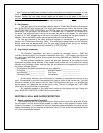
Blower
Wiring
Valve/Thermostat
Wiring
SECTION VII: FIRST FIRE HINTS YOU SHOULD KNOW
A. Lighting the Pilot
Some additional pointers or guidelines about lighting the pilot may be helpful. First time ignition should be
done by a qualified service person. This technician has the knowledge to trouble shoot the system and adjust
the pilot light if required. Purging the air out of the gas line is also a common problem that could require repeated
attempts to light the pilot.
Once the pilot is burning, by looking from the front of the stove you can see a flame -- this small, yellow
tipped, blue flame should be visible when the main burner is not operating. When the main burner is on, it is
evident from the larger visible flame in the firebox. The main burner will now respond to the thermostat setting.
Pilot Flame Size Firebox Flame Size
B. Smoke and Odor
There will be some visible smoke and some odors coming from the stove with the first few fires. These are
caused by the burning of binders from the logs and brick fiberboard, oils from the manufacturing process and
curing of the painted surface of the stove. This “off-gassing” will cease after a few fires; however, it is a good
idea to open some windows and doors in your dwelling during this time.
While this “off-gassing” is occurring, the brick fiberboard will turn a dark color. This is only a temporary effect,
and it should return to the original color after a few fires.
In the beginning, the flames will be taller than normal, and may even hit the top inside of the stove. The
binder in the logs and brick fiberboard acts as fuel, and can make the flame burn higher. This will correct itself
after a few fires and the flame should stabilize at a height of no more than 85% of the front glass window.
Blower and Valve/Thermostat Wiring Diagrams for this Unit


















